Dear Artist,
Mobile easels include everything that goes by land, sea or air. My friend Toni Onley used to paint from the cockpit of his amphibian Lake Buccaneer. Floating studios permit the marvel of drifting — silent, Zen-like contemplation and rendering along waterways. There’s nothing like a rowboat or canoe — tethered or not. A small custom unit can be made to fit a kayak — the “Keasel” — where water-based brush swizzling is a piece of cake. A few years ago I built an “Art-Dog,” a mobile paintbox I towed behind my bike. I actually patented the unit but no one was interested. If you want to paint using a trail bike, set the kickstand and paint facing backwards.
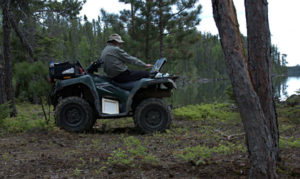
All Terrain Vehicle as mobile studio. In the deep bush, getting off the ground is useful — with ticks, ants, and other pestilence in evidence.
There’s nothing wrong with the family car. The back seat is the cocoon of choice on rainy days — on sunny ones you might try standing up in the moonroof with the paintbox and other stuff in front of you on the roof. Make sure you’ve come to a stop if you decide to paint behind the wheel. Small hooks or screw eyes in the back of the canvas permit bungeeing to a nicely angled steering wheel. Ultimate comfort comes with a motorhome, where setting up at the picture window can give a new view every day.
For really remote, nearly inaccessible terrain, nothing beats a quad. ATVs improve bush travel and open up areas previously only suitable for hiking. A stable painting platform when you arrive, the only downside is the racket they make in getting there. I’ve noticed when other people drive them in the wilderness the racket bothers me more than when I’m making it. Yesterday, in western Ontario, I drove 75km to a precious place that would have taken several days to hike into. There were six of us quadders in the party, so if any tree-huggers got exercised I had help in fighting them. As it was we saw no one but a solitary moose, and he seemed blasé to our passage. The paintbox was bungeed to the carrier rack and I faced rearwards to paint.
Mobile workstations are only limited by an artist’s imagination or inclination. Odd-ball transport gives unique material, new perspectives, as well as adding oft-needed variety and opportunity. Apart from that, they add even more fun to an already fun job.
Best regards,
Robert
PS: “Today I drifted [in the floating studio]with Camille on the Seine at Argenteuil. The views materialized and dissolved and I was as contented as a cow in her stall.” (Claude Monet, 1874)
Esoterica: The basic mobile unit is the paintbox. Some artists prefer comprehensive ones with everything but the kitchen sink. I take a Spartan approach. I’ve done a lot of backpacking where lightness counts and where a cigar box with a few basic colours and sawed-off brushes works just fine. You may be a little embarrassed about it, but you’ll really get off on a certain smug feeling you get when you arrive at a remote location, open your tiny office, squeeze out and produce something of value.
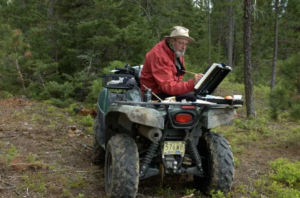
The rear rack on the ATV makes an excellent platform.
This letter was originally published as “Mobile methodologies” on June 24, 2008.
Have you considered a Premium Artist Listing? With each letter, an artist is featured at the bottom of this page. The Premium Artist Listings are a means of connecting artist subscribers through their work. Proceeds from each listing contribute to the production of The Painter’s Keys.
When you’ve got it, you’ve got it. When you haven’t, you begin again. All the rest is humbug. (Edouard Manet)
Featured Workshop
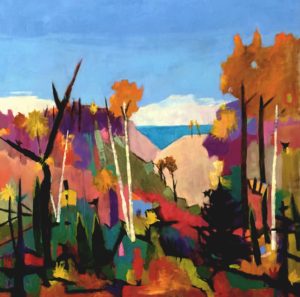 Permission to Paint Expressively Series Session 1
Permission to Paint Expressively Series Session 1
June 27-30, 2022
Join Ellie Harold for “Expressive Painting: Color from the Inside Out.” Do you struggle with color? For chromophobics or anyone who would like greater freedom in their use of color, this workshop focuses on activating and applying your innate color sense. Content, process and lightly structured exercises allow you access to a wider range of color expression in the safe space of Ellie’s studio, located only 3 blocks from Lake Michigan near Sleeping Bear Dunes. “Expressive Painting: Color from the Inside Out” has the potential to transform not only your art but your life! Details and registration at www.EllieHarold.com.
Featured Artist
There are two elements in my artistic development that contribute to my work daily:
– I fell in love with water medium early, and will continue to learn from it for as long as I paint. No one really masters watercolour; it remains a thing apart, and therein lies its beauty.
– About six years into painting, I discovered alternative watercolour surfaces (canvas, board and collage), with the result that I rarely paint on paper any more. Each surface presents different challenges and different rewards, and I find myself shifting from one to another according to the mood and subject of each piece.

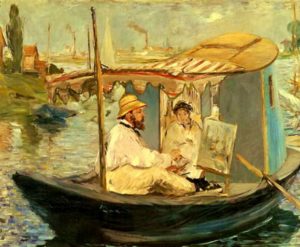
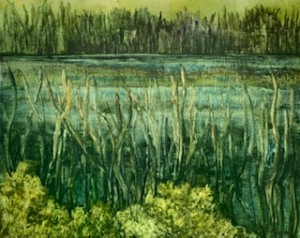



11 Comments
The back of an SUV with the hatch up works great, even in the rain. If it gets too hot, a reflector over the hatch door creates nice shade. I set up my easel under the hatch and sit on the “tailgate” , the cross supports on my easel hold my palette and extra paint, turps, etc. are beside me in the back of the SUV. I paint on toned canvas which is VERY helpful if you cannot find a shady spot for the canvas. Looking at a bright white canvas in the sun skews your view of the scene. For really sunny days, I use a very dark blue ground which helps keep the scene in proper tone. For some reason, I do not like to paint on a white ground.
I wondered what to do with my ATV now that I have given up deer hunting. Robert hated guns, but I loved him anyway.
All of these suggestions are good until you are 85. So try them while you are still young while contortions are possible and painless.
cooI recently usedsdsss
I would like to extend my sincere thanks to you for this inspiring article. Every word you write touches my heart and soul. I hope you will continue to share your thoughts and experiences. Play game planet clicker free.
AI can take into account previous actions, preferences, geolocation, time of day, device type, and other data for personalization. For example, https://fivecube.agency/blog/using-ai-to-personalize-ux-without-losing-humanity Using AI to personalize UX can recommend content, reorder elements on a page, adapt the interface for novice or advanced users, or predict next actions based on behavioral patterns.
This blog information is very great aarp united healthcare
Some artists prefer comprehensive ones with everything but the kitchen sink. I take a Backrooms Game Spartan approach.
Author Robert uses a witty and humorous tone to share a range of creative and unique ideas, from painting on a canoe to building a custom “Art-Dog” for a bicycle. Personal anecdotes google doodle baseball, such as the story of his friend Toni Onley painting from the cockpit of an airplane and his experiences with four-wheeling, make the advice feel real and adventurous.
This whimsical ode to mobile easels celebrates the boundless creativity of painting on the move. From amphibious aircraft to rowboats, trail bikes to motorhomes, each mode of transport becomes a studio—offering fresh perspectives and unexpected comforts. wisely adp
sled rider: so fun!